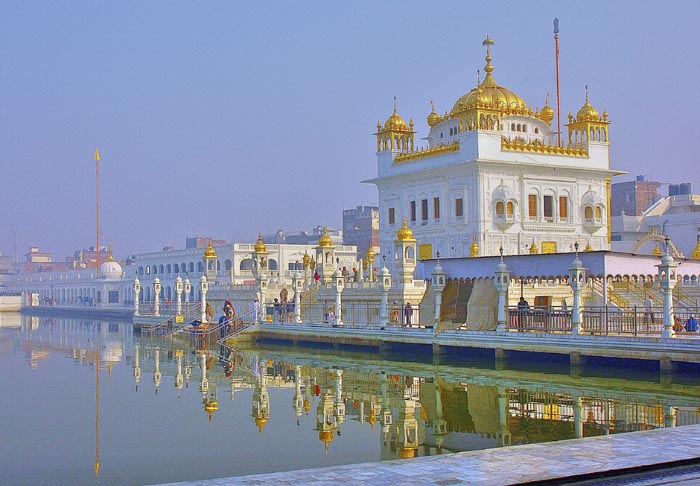Gurdwara Sri Tarn Taran Sahib

Information of Gurdwara Sri Tarn Taran Sahib, Amritsar, Punjab
Gurudwara Sri Tarn Taran Sahib is located in the district of Tarn Taran Sahib, in the state of Punjab, in Northwest India. It is a gurdwara that was established in a successful manner by the fifth guru named Guru Arjan Dev. This particular site has the unique distinction of having the largest water pond or sarovar of all the gurdwaras. Actually, this particular Gurudwara is famous for the monthly large scale gathering of pilgrims from far and near on the day of no-moon night or Amavas. It is one of the most visited and frequented religious spot by the Sikh people daily, on festive days and auspicious days.
Gurdwara Sri Tarn Taran Sahib Religious Significance
In the Land of Panjab, in the year 1590, Guru Arjan Dev Ji who was the Fifth Sikh Guru founded Tarn Taran Sahib. At that particular time, the activities related to the digging of the lake tank immediately started. This task was completed in a successful manner and then it was the largest and biggest sarovar lake in the whole of Punjab. A famous Sikh saint who was named Dhan Dhan Baba Buddha Ji, (1506-1631) laid the foundation stone of Darbar Sahib. It is to be remembered that the Sixth Sikh Guru, Guru Hargobind Sahib visited this gurdwara plus stayed for some days. The ninth Sikh Master named Guru Tegh Bahadur also visited Tarn Taran Sahib plus wholeheartedly preached to the Sikh Sangat with a lot of perfection. In 1757, Baba Deep Singh Shaheed visited Tarn Taran Sahib and made a historical and religious mark on the ground, plus he requested the Sikhs if they were really ready to die fighting with dedication and commitment against the enemies before entering into actual war against the Mughal Empire. The personalities who joined hands in 1768 in order to rebuild the Darbar Sahib Tarn Taran were Maharaja Jassa Singh Ramgarhia of Ramgarhia Misl and Sardar Budh Singh Virk of Singhpuria Misl. During 1799-1839, Maharaja Ranjit Singh Sher-e-Panjab visited Darbar Sahib Tarn Taran. In 1836-1837, he reconstructed the current Darbar Sahib Tarn Taran. He in a successful manner completed the task of the Parikarma that had been largely left unfinished by the two Sikh Sardars named Ramgarhia Misl and Singhpuria Misl. Maharaja Ranjit Singh added gold-plate to the Darbar Sahib Tarn Taran as same as he successfully with the Harmandir Sahib located in Amritsar.
Gurdwara Sri Tarn Taran Sahib Architectural Significance
The Maharaja of Punjab Kingdom called upon vast experienced and highly qualified artisans in order to decorate the interior of Darbar Sahib Tarn Taran. It was built with 17 massive gate entrances in Tarn Taran in which even elephants and group of horses could easily go through with a lot of perfection. At the end of the sarovar, a minara (tower) was built by Maharaja Nau Nihal Singh who was the grandson of Sher-e-Punjab Maharaja Ranjit Singh. Actually four towers were planned but one was completed and rest was unfinished because of his sudden death and largely because of the two Anglo-Sikh Wars that happened during 1845-1849 against the British. The task of beautifying the tank and regularly filling the tank with water was done by Raja Raghubir Singh who was the Sikh Chieftain of Jind Princely State in 1883. He dug a channel to bring water from nearby available sources.
Festivals at Gurdwara Sri Tarn Taran Sahib
The building structure of Gurudwara Sri Tarn Taran Sahib is well-decorated during the Sikh festive and auspicious days. At Gurudwara Sri Tarn Taran Sahib, most of the major and minor Sikh festivals and auspicious days are grandly celebrated in a religious manner. A large number of adherent devotees and local people along with pilgrims attend prayer meeting at this gurudwara. Though this holy Gurudwara observes very small and important festivals only in the mark of birth of Sikh Gurus, yet it calls for an ample of devotees to be the part of the festivals that is celebrated out here. Devotees and locals in a great number gather to celebrate the festivals in a grandeur and joyful way. They wholeheartedly hear to the religious lecture given by eminent personalities belonging to the Sikh religion.